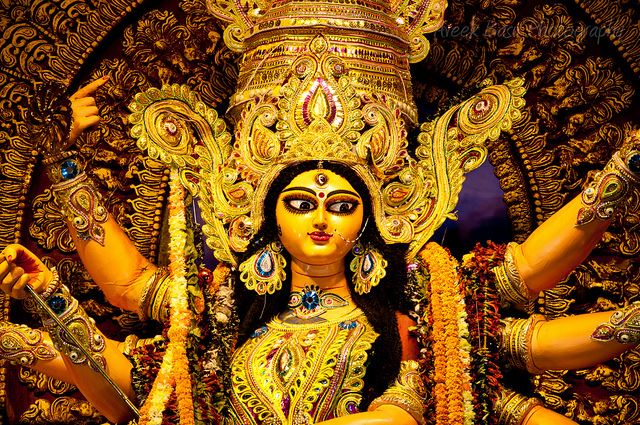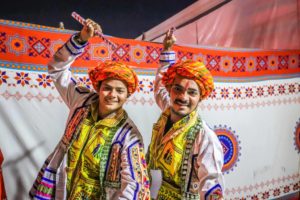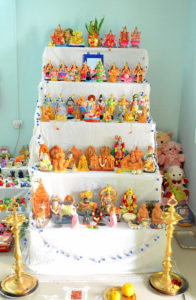9 Indian states celebrating Navratri in 9 different ways

Navratri is devoted to goddess Durga & some states in South India also dedicate it to other Hindu deities like Saraswati, the goddess of knowledge (MIG Photos)
The Hindu festival of Navratri, which means nine (nav) nights (ratri) in Sanskrit, is celebrated over nine consecutive nights during the autumn. The celebrations vary across regions, according to local customs and traditions, but the main theme of the festival is the victory of good over evil. Although Navratri is devoted to goddess Durga, some states in South India also dedicate it to other Hindu deities like Saraswati, the goddess of knowledge.
Here is a journey through different states of India that celebrate Navratri in different ways.
Experiencing Kullu Dussehra of Himachal Pradesh

The state government has also accorded the status of an International festival to Kullu Dussehra that attracts more than half a million people
Navratri celebrations in Himachal Pradesh take place on the tenth day of the Navratri. Just when the celebrations are ending in other states of the country, Himachal Pradesh is seen gearing up for the day, keeping its best foot forward.
The celebrations on the tenth day are known as Kullu Dussehra, marking the return of Lord Ram to Ayodhya. It is marked by the extremely popular Festival of Kullu Valley. On this day, the entire valley is decked up in bright hues of decorations adorning its streets. A huge procession carrying idols of gods and goddesses to the main ground is a highlight of the festival that is celebrated with great pomp and enthusiasm. Various dance, musical and other cultural performances also mark this day and offer a unique opportunity for visitors to familiarise themselves with the local culture. The festival concludes with the very famous performance of Lankadahan (burning of Lanka) by the side of Beas River, an experience that would stay with one for a lifetime!
The state government has also accorded the status of the International festival to Kullu Dussehra that attracts more than half a million people from different corners of the world. While music and colour create a peaceful ambience, thousands of people gather on the first day of celebration to pay respect to local deities. The first day starts with huge celebration and the statue of Lord Raghunath, a local deity, is installed on a beautifully designed chariot, which is pulled by ropes by the locals from its place to different sites across the city.
Also Read – Let’s dance Garba on Navratri in Gujarat.
Navratri marks the arrival of festive season in India.
Watching Ramleela in Uttar Pradesh & Bihar
In UP and Bihar, Navaratri is celebrated with the Ramleela- a dramatic enactment of the life of Lord Ram from the Hindu epic Ramayana – performed in theatres, temples and temporary stages. After nine days, effigies of Ram’s enemy, demon Ravana and his brothers Kumbhakarna and Meghanada are burnt to symbolise the end of all evil. The whole ceremony is followed by an extraordinary display of fireworks.
Pandal hopping in West Bengal

During the celebrations, elaborately designed pandals (marquees) and life-size statues of the goddess Durga are installed here in every neighbourhood (MIG Photos)
In West Bengal and in most eastern states like Assam, Tripura, Odisha and Jharkhand, Navratri is celebrated as Durga Puja, the main annual festival for Bengali Hindus that commemorates the victory of Durga over the shape-shifting buffalo demon Mahishasura. During the celebrations, elaborately designed pandals (marquees) and life-size statues of the goddess Durga are installed here in every neighbourhood. Dressed in traditional attire, devotees offer prayers in the evening and perform a dhunuchi naach, a special dance with earthen lamps.
The colourful cultural displays, the lively atmosphere, the bright lights adorning the city-under the spell of Durga Puja, the City of Joy surely does begin to do justice to its name. Dancing to upbeat dhaak beats, going on a pandal-hopping spree, munching on lip-smacking bhogs, wearing beautiful attire is a must-do during Durga puja in West Bengal.
Visiting the fun-filled melas in Rajasthan
Navratri in Rajasthan is marked by the famous Dussehra Mela (fair). During Dussehra, melas become the centre of all attention and thousands of people flock to the large ground to celebrate. A 72-foot effigy of Ravana, the tallest in India, is also busted with crackers. Later, a fair of 20 days is arranged across different cities in Rajasthan till Dhanteras, which marks the beginning of Diwali, another religious festival in India.
The Dussehra mela marks the beginning of the festive season in Rajasthan. One can witness people wearing beautiful traditional garments, children frolicking on the Mela ground, people offering their prayers to Goddess Durga and infectious energy that sweeps over the city.
Performing Garba in Gujarat

Navaratri in Gujarat is also known for the garba raas, a traditional dance performed by men and women around the garbo or an idol of Durga (MIG Photos)
The state of Gujarat has a unique way of celebrating Navaratri. And it is this version of the celebrations that has seeped into popular culture. Devotees observe fast for nine days to honour Durga and her nine different incarnations. Every evening, women who are fasting dedicate their prayers to an earthen pot lit with diyas (candles). The pot, called garbo, represents the source of life and the light represents shakti (power).
Navaratri in Gujarat is also known for the garba raas, a traditional dance performed by men and women around the garbo or an idol of Durga. The word Garba or Garbha means womb and in this context the lamp in the pot, symbolically represent life within a womb.
Celebrating Bathukamma in Andhra Pradesh
During the Navratri festival, it is time for the women of Andhra Pradesh to invoke Mother Gauri, the benign goddess, for blessing them with conjugal bliss. Unmarried girls join the communal worship to seek a spouse of their choice. The festival is called Bathukamma Panduga in the Telugu language which means Mother Goddess, Come Alive! Women create flower stacks in time-honoured style using local flowers for the worship of Mother Divine. On the final day of the festival, this stack is immersed in a lake or a river.
Mesmerising Mysore Dasara of Karnataka

On the ninth day of the festival, the royal sword is set on a throne to be worshipped and taken on a procession of elephants & horses
Mysore Dasara is the Nadahabba or the state-festival of Karnataka, celebrated with utmost spectacle and joy in the city of Mysore where it follows the same rituals that were first practised by King Raja Wodeyar I in 1610. On mahanavami (the ninth day of the festival), the royal sword is set on a throne to be worshipped and taken on a procession of elephants and horses. On the 10th day (dashami), another grand procession of dancers and musicians escorting an image of goddess Chamundeshwari (a form of Durga) mounted on a golden saddle atop an elephant is carried through the city.
Worshipping the goddess of wisdom in Kerala
The last day of Navratri, also called Vijayadashmi, is celebrated in Kerala by decorating 108 Durga temples. People of the most literate state in India also prefer to instil their own values of education, worship of domestic animals and vehicles in their celebrations. On this day, Keralites worship Goddess Saraswati and students keep their books in front of her idol for two days along with other offerings such as sugarcane or jaggery. The celebration is blended with Kerala’s own local culture and traditions and a taste of the same by any passing tourist is indeed a soulful experience.
Also Read – Vibrant Gujarat Navratri Festival.
Durga Puja celebrations across India.
Durga Puja Celebration in Kolkata.
Displaying kolu in Tamil Nadu

the display of kolu (figurines of dolls), which are arranged to narrate popular legends from the Hindu scriptures
In the southern state of Tamil Nadu, Navaratri pays homage not only to Durga but also to other Hindu goddesses like Laxmi and Saraswati. Legends say that the three goddesses are venerated on three separate days during which friends and family gather to celebrate and exchange gifts, such as clothes, sweets and coconuts. Another custom typical of the Navaratri celebrations in Tamil Nadu is the display of kolu (figurines of dolls), which are arranged to narrate popular legends from the Hindu scriptures.
Ayudha Puja is also conducted in many parts of Tamil Nadu on the Mahanavami (Ninth) day with much fanfare. Agricultural implements, tools, books, musical instruments, machinery and automobiles are decorated and worshipped on this day along with Goddess Saraswati.









